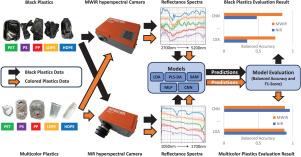中波红外高光谱成像识别黑色塑料
IF 7.1
2区 环境科学与生态学
Q1 ENGINEERING, ENVIRONMENTAL
引用次数: 0
摘要
在近红外(NIR)范围内工作的基于传感器的分选机通常用于对消费后塑料进行分选。然而,当近红外光被黑色塑料中的炭黑颜料完全吸收时,这种方法就失败了。中波红外(MWIR)被炭黑吸收较少,因此为分析黑色聚合物提供了一个有前途的替代波长范围。本研究比较了MWIR和NIR高光谱成像对黑色和彩色塑料垃圾的分类。我们收集了消费后包装中常见的五种聚合物的光谱数据,即高密度聚乙烯(HDPE)、低密度聚乙烯(LDPE)、聚对苯二甲酸乙二醇酯(PET)、聚丙烯(PP)和聚苯乙烯(PS)。我们使用几种化学计量学方法对光谱进行分类,包括卷积神经网络(CNN)。结果定量验证了MWIR在黑色塑料分类上优于NIR的性能。当使用CNN时,MWIR的平衡精度为83.4%,而NIR的平衡精度为47.5%,在所有传感器和样本集上都优于其他化学计量方法。另一方面,在平衡精度方面,有色塑料的近红外比MWIR高出7个百分点。这些发现表明,MWIR高光谱成像是一种有效的替代近红外高光谱成像,用于分类消费后包装废物,特别是当黑色塑料的份额很高。本文章由计算机程序翻译,如有差异,请以英文原文为准。

Black plastic identification by hyperspectral imaging in mid-wave infrared
Sensor-based sorters operating in the Near-Infrared (NIR) range are commonly used to sort post-consumer plastics. However, this method fails, when the NIR light is fully absorbed by carbon black pigments, which are present in black plastics. Mid-Wave Infrared (MWIR) is less absorbed by carbon black and therefore provides a promising alternative wavelength range for analyzing black polymers. This study compares MWIR to NIR hyperspectral imaging for classifying black and colored plastic waste. We collected spectral data from five common polymers found in post-consumer packaging, namely High-Density Polyethylene (HDPE), Low-Density Polyethylene (LDPE), Polyethylene Terephthalate (PET), Polypropylene (PP), and Polystyrene (PS). We classified the spectra using several chemometric methods, including a convolutional neural network (CNN). The results quantitatively verify the superior performance of MWIR over NIR for classifying black plastics. MWIR achieved a balanced accuracy of compared to for NIR, when using a CNN, which outperformed other chemometric methods for all sensors and sample sets. On the other hand, NIR surpasses MWIR by 7 percentage points for colored plastics in balanced accuracy. These findings suggest that MWIR hyperspectral imaging is an effective alternative to NIR hyperspectral imaging for sorting post-consumer packaging waste, especially when the share of black plastics is high.
求助全文
通过发布文献求助,成功后即可免费获取论文全文。
去求助
来源期刊

Waste management
环境科学-工程:环境
CiteScore
15.60
自引率
6.20%
发文量
492
审稿时长
39 days
期刊介绍:
Waste Management is devoted to the presentation and discussion of information on solid wastes,it covers the entire lifecycle of solid. wastes.
Scope:
Addresses solid wastes in both industrialized and economically developing countries
Covers various types of solid wastes, including:
Municipal (e.g., residential, institutional, commercial, light industrial)
Agricultural
Special (e.g., C and D, healthcare, household hazardous wastes, sewage sludge)
 求助内容:
求助内容: 应助结果提醒方式:
应助结果提醒方式:


